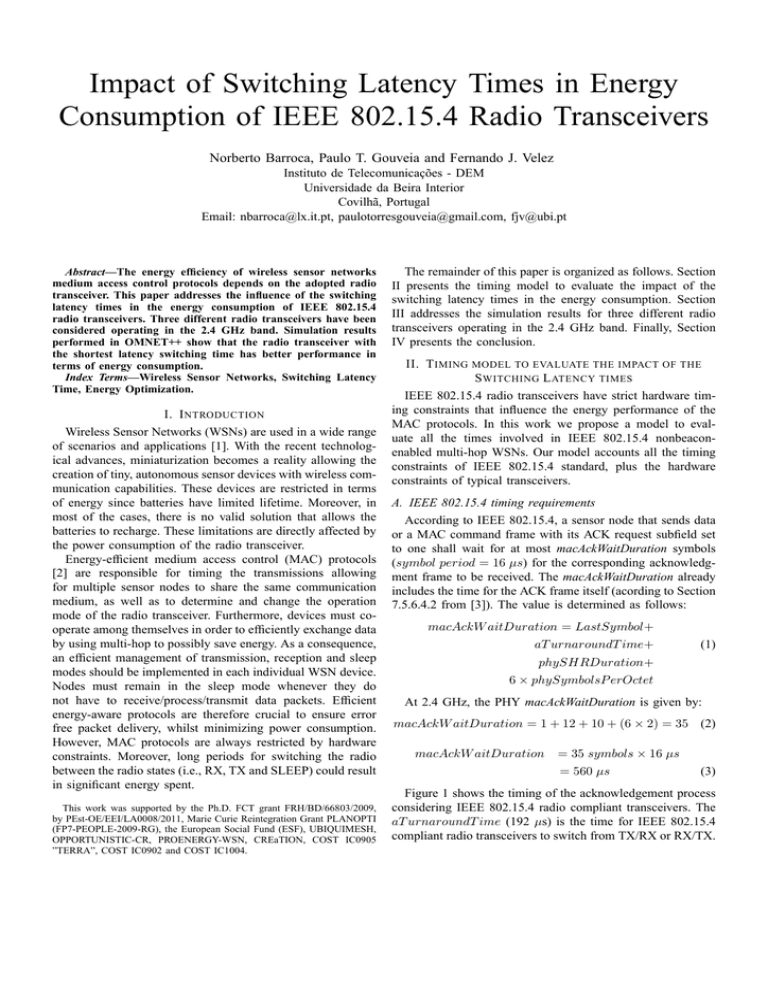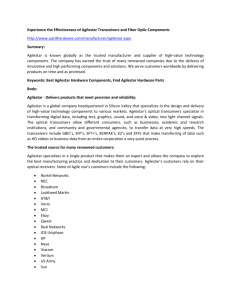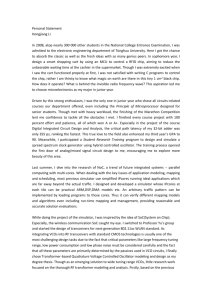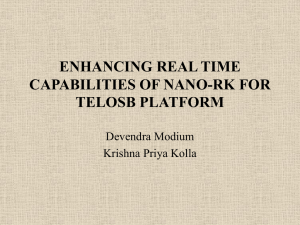Impact of Switching Latency Times in Energy
advertisement

Impact of Switching Latency Times in Energy Consumption of IEEE 802.15.4 Radio Transceivers Norberto Barroca, Paulo T. Gouveia and Fernando J. Velez Instituto de Telecomunicações - DEM Universidade da Beira Interior Covilhã, Portugal Email: nbarroca@lx.it.pt, paulotorresgouveia@gmail.com, fjv@ubi.pt Abstract—The energy efficiency of wireless sensor networks medium access control protocols depends on the adopted radio transceiver. This paper addresses the influence of the switching latency times in the energy consumption of IEEE 802.15.4 radio transceivers. Three different radio transceivers have been considered operating in the 2.4 GHz band. Simulation results performed in OMNET++ show that the radio transceiver with the shortest latency switching time has better performance in terms of energy consumption. Index Terms—Wireless Sensor Networks, Switching Latency Time, Energy Optimization. I. I NTRODUCTION Wireless Sensor Networks (WSNs) are used in a wide range of scenarios and applications [1]. With the recent technological advances, miniaturization becomes a reality allowing the creation of tiny, autonomous sensor devices with wireless communication capabilities. These devices are restricted in terms of energy since batteries have limited lifetime. Moreover, in most of the cases, there is no valid solution that allows the batteries to recharge. These limitations are directly affected by the power consumption of the radio transceiver. Energy-efficient medium access control (MAC) protocols [2] are responsible for timing the transmissions allowing for multiple sensor nodes to share the same communication medium, as well as to determine and change the operation mode of the radio transceiver. Furthermore, devices must cooperate among themselves in order to efficiently exchange data by using multi-hop to possibly save energy. As a consequence, an efficient management of transmission, reception and sleep modes should be implemented in each individual WSN device. Nodes must remain in the sleep mode whenever they do not have to receive/process/transmit data packets. Efficient energy-aware protocols are therefore crucial to ensure error free packet delivery, whilst minimizing power consumption. However, MAC protocols are always restricted by hardware constraints. Moreover, long periods for switching the radio between the radio states (i.e., RX, TX and SLEEP) could result in significant energy spent. This work was supported by the Ph.D. FCT grant FRH/BD/66803/2009, by PEst-OE/EEI/LA0008/2011, Marie Curie Reintegration Grant PLANOPTI (FP7-PEOPLE-2009-RG), the European Social Fund (ESF), UBIQUIMESH, OPPORTUNISTIC-CR, PROENERGY-WSN, CREaTION, COST IC0905 ”TERRA”, COST IC0902 and COST IC1004. The remainder of this paper is organized as follows. Section II presents the timing model to evaluate the impact of the switching latency times in the energy consumption. Section III addresses the simulation results for three different radio transceivers operating in the 2.4 GHz band. Finally, Section IV presents the conclusion. II. T IMING MODEL TO EVALUATE THE IMPACT OF THE S WITCHING L ATENCY TIMES IEEE 802.15.4 radio transceivers have strict hardware timing constraints that influence the energy performance of the MAC protocols. In this work we propose a model to evaluate all the times involved in IEEE 802.15.4 nonbeaconenabled multi-hop WSNs. Our model accounts all the timing constraints of IEEE 802.15.4 standard, plus the hardware constraints of typical transceivers. A. IEEE 802.15.4 timing requirements According to IEEE 802.15.4, a sensor node that sends data or a MAC command frame with its ACK request subfield set to one shall wait for at most macAckWaitDuration symbols (symbol period = 16 μs) for the corresponding acknowledgment frame to be received. The macAckWaitDuration already includes the time for the ACK frame itself (acording to Section 7.5.6.4.2 from [3]). The value is determined as follows: macAckW aitDuration = LastSymbol+ aT urnaroundT ime+ phySHRDuration+ 6 × phySymbolsP erOctet (1) At 2.4 GHz, the PHY macAckWaitDuration is given by: macAckW aitDuration = 1 + 12 + 10 + (6 × 2) = 35 (2) macAckW aitDuration = 35 symbols × 16 μs = 560 μs (3) Figure 1 shows the timing of the acknowledgement process considering IEEE 802.15.4 radio compliant transceivers. The aT urnaroundT ime (192 μs) is the time for IEEE 802.15.4 compliant radio transceivers to switch from TX/RX or RX/TX. sinks, has been considered. Figure 3 shows the multi-hop star topology OMNeT++ [5] simulation setup. The packets from source node A flow, through node C, to sink node D, while the packets originated by source node B flow, through node C, to reach sink node E. Fig. 1. DATA/ACK handshake from IEEE 802.15.4. IEEE 802.15.4 radio compliant transceivers use CSMA/CA to access the medium for their data transmissions. The algorithm is implemented in units of time called backoff periods. One backoff period is equal to aU nitBackof f P eriod symbols (i.e, 20 symbols, for IEEE 802.15.4). Before trying to sense the channel, a device shall wait for a specified number of backoff periods, determined by the backoff exponent (BE). The transceiver randomly selects a backoff time from a number between 0 and 2BE −1. Each device considers a macM inBE time value before starting a new transmission and increments it after every failure to access the channel. The Initialbackof f P eriod is given as follows: Initialbackof f P eriod = (2BE − 1)× aU nitBackof f P eriod (4) When a node is in the RX state and the backoff timer expires, node perform the CCA before transmitting a packet. This time delay, due to CCA, is given by: ccaT ime = rxSetupT ime + ccaDetectionT ime (5) The rxSetupT ime is the time to switch the radio between the different states and must be taken from the datasheet of the radio transceiver. During the ccaDetectionT ime, the radio transceiver must determine the channel state within the duration of 8 symbols (i.e, 128 μs) as defined in the IEEE 802.15.4 standard. Figure 2 presents the timing for transmitting a data packet by considering CC2420 [4]. Fig. 3. Multi-hop star topology simulation scenario. The star network topology is challenging because there are abundant overhearing opportunities between neighbouring nodes. A node acting as the coordinator may therefore take advantage of these opportunities to seek network optimization. The star topology may also be viewed as a part of a larger network. Therefore, this type of network can be viewed as a building block for larger scale wireless networks [6]. The analysis of the sensor nodes performance is done through simulation by considering three different radio transceivers operating at 2.4 GHz. The CC2420, CC2520 [7] and AT86RF231 [8] transceivers. Table I shows the specifications of the radio transceivers, where P indicates the power consumed in each state (a supply voltage of 3V is considered). TABLE I S PECIFICATIONS OF THE CONSIDERED TRANSCEIVERS . Parameter PSleep [μA] PReceive [mA] PT ransmit [mA] T ransmit rate [kb/s] aT urnaroundT ime [μs] ccaDetectionT ime [μs] rxSetupT ime [μs] ccaT ime [μs] CC2420 0.02 18.8 17.4 250 192 128 1792 1920 CC2520 0.03 18.5 25.8 250 192 128 1792 1920 AT86RF231 0.02 12.3 11.6 250 192 128 400 528 In this research, we have created an energy model based in [9]. The energy consumption over a period of time t is given as follows: Fig. 2. E(t) = [TT X × PT X ] + [TRX × PRX ] +[TSleep × PSleep ] + [TI × PI ] Timing for transmitting a data packet. Besides, for every data packet transmitted, there is a random deferral period of time before transmitting that is given by: DT = Initialbackof f P eriod + rxSetupT ime +ccaDetectionT ime + aT urnaroundT ime (6) B. Energy Consumption In order to know how much energy is spent by the radio transceivers on each state, an analytical model was conceived. A two-hop network, with two sources, one relay and two (7) The meaning of each variable is presented in Table II. We assume that for all radio transceivers the energy consumption is equal for both IDLE and RX states. As shown in Table I, the transmission power is significantly different for each IEEE 802.15.4 transceivers. Besides, the time for the rxSetupT ime of the AT86RF231 transceiver is considerably lower than for the CC2420 and CC2520 transceivers. By analyzing equation (6), we can conclude that the rxSetupT ime (the node switching delay time) has a higher impact in the CCA of the IEEE 802.15.4 radio transceivers. Hence, with longer warm-up times the energy TABLE II N OTATIONS FOR THE ESTIMATION OF THE ENERGY. Parameter The amount of time the node has spent Power consumption in the TX state The amount of time the node has spent Power consumption in the RX state The amount of time the node has spent Power consumption in the SLEEP state The amount of time the node has spent Power consumption in the IDLE state in TX state in RX state in SLEEP state in IDLE state spent by each node is augmented, since it has direct influence in the total time a node is consuming power. Figure 4 presents the conceptual profile energy of a sensor node that switches the radio transceiver between the IDLE and SLEEP states, given by τi,s and τs,i ,which also corresponds to the rxSetupT ime value presented in the datasheets of the IEEE 802.15.4 compliant transceivers. Fig. 4. TABLE III S IMULATION PARAMETERS . Parameter Channel bitrate Operating frequency Bandwidth Modulation Transmission power Channel model Minimum path loss coefficient Data packet size Control packet size (ACK/RTS/CTS) Duty cycle Listen Period Retransmission limit Number of runs Maximum simulation time Packet inter-arrival time Energy savings and transitions for sleep modes. By considering different switching latency times, the expected results for the energy consumption on each state are the following: • Every time a node performs CCA, it is in RX mode. Since CC2420 and CC2520 have the longest switching delay times, it is expected that they spend longer time in the RX mode than the AT86RF231 radio transceiver; • CC2420 has the highest power consumption in the RX state, it is expected to have the worst performance in terms of energy consumption; • The AT86RF231 transceiver is the one with the lowest power consumption in the RX state, so it is expected to have a better energy performance when compared with CC2420 and CC2520; • In the TX state, the radio transceiver with the worst energy performance is the CC2520, while AT86RF231 is the one with the best performance, so it should always outperforms the CC2520 transceiver in this state; • The switching delay times from IDLE to SLEEP and SLEEP to IDLE must be considered (this value is given by the rxSetupT ime). Longer wake-up means longer delay but more energy is saved. • During the SLEEP state, the radio transceiver with the worst performance is CC2520, however the impact of this state always depends on the duty cycle conditions. III. R ESULTS To evaluate the impact of the switching delay times (rxSetupT ime) imposed by the hardware in the network Value 250 kb/s 2.4 GHz 2 MHz O-QPSK 0 dBm (1 mW) Free-space path loss 2.5 44 bytes 11 bytes 12 % 0.15642 s 2 5 100 s from 1 to 10 s The simulations have been performed by considering the multi-hop star topology simulation scenario presented in Fig. 3, with a duty cycle of 12%. Each source node sends 100 data packets, with a data generation interval between 1 and 10 s. Simulations have been run five times for each seed. Figure 5 shows the average energy consumption of the nodes for each packet inter-arrival time for the CC2420, CC2520 and AT86RF231 radio transceivers. The achieved 95 % confidence intervals are negligible. 600 Energy Consumption [mJ] Notation TT X PT X TRX PRX TSleep PSleep TI PI performance we have implemented IEEE 802.15.4 for the nonbeacon-enabled mode by using the OMNeT++ componentbased C++ simulation library with the MiXiM framework. We have included a RTS/CTS exchange mechanism in order to avoid the hidden terminal problem for the nonbeacon-enabled multi-hop wireless networks, which may significantly degrade their performance [10], [11]. Nodes that hear either the RTS, CTS, data or acknowledgment packet, set an internal timer called Network Allocation Vector (NAV) to the remaining duration indicated in the respective frame, and go to the sleep mode until the timer expires. This way, interference is avoided, and energy usage is improved. Table III presents the key parameters considered in our simulations. CC2420 CC2520 AT86RF231 500 400 300 200 100 0 1 2 3 4 5 6 7 Packet inter-arrival time [s] 8 9 10 Fig. 5. Energy consumption for the CC2420, CC2520 and AT86RF231 transceivers. As shown in Fig. 5, when the packet inter-arrival time increases, the energy consumption of all radio transceivers also increases. The AT86RF231 transceiver has always the best performance, followed by CC2520, and by CC2420, which has the worst performance. As shown in Table I, the CC2420 and CC2520 transceivers have the same switching delay time (rxSetupT ime), leading to a equal random deferral period of time before transmitting. Hence, in these cases the energy consumption does not depend on the direct comparison of the switching latency time, being only influenced by the power spent in the TX/RX/SLEEP states. For a packet inter-arrival time between 1 and 4 s, CC2520 has worst performance in terms of energy consumption than CC2420, since the amount of time spent in TX state is longer than the time spent in RX or SLEEP states. For a packet inter-arrival time between 5 and 10 s, since the nodes spend more time in the RX or SLEEP states, CC2520 has always the best performance when compared with the CC2420 transceiver. The AT86RF231 transceiver spends around 3.64 times less time in the CCA procedure than CC2420 and CC2520. Besides, it has the best performance in terms of energy consumption in the RX/TX states. Since in most of the active time period the node is in the RX or TX state, the AT86RF231 has got the best results in terms of energy consumption. The energy spent on each state by CC2420, CC2520 and AT86RF231 is presented in Fig. 6. The energy spent on the SLEEP state is negligible, when compared with the RX/TX states. Current draw (mA) 25 SLEEP RX/IDLE TX 20 than CC2420 in the RX/IDLE states, while the AT86RF231 transceiver consumes approximately 35% less energy than the CC2420 transceiver in the RX/IDLE states. IV. C ONCLUSION In this paper, we have analyzed the influence of the switching delay times imposed by the hardware constraints of the IEEE 802.15.4 compliant radio transceivers. Three radio transceivers have been considered, operating in the 2.4 GHz band, with different switching delay times and values for the energy consumption. A star topology network in which nodes communicate using the central node as a relay, was simulated in the MiXiM framework of OMNeT++. Results show that the radio transceiver with lower switching delay time (i.e., AT86RF231) has the lowest global energy consumption, as it spends less time performing the CCA procedure. For radio transceivers with the same switching delay time (i.e., CC2420 and CC2520), for high traffic loads (i.e, packet inter-arrival time between 1 and 4 s) the one which spends less energy in the transmitting state (i.e., CC2420) has the lowest energy consumption, since this is the state more frequently used by the radio. For light traffic loads (i.e., packet inter-arrival time between 5 and 10 s), since a node spends more time in the RX or SLEEP states, CC2520 has always the best performance when compared with CC2420. The range of values for the switching delay times is not defined by the IEEE 802.15.4 standard itself but by the hardware of the radio transceiver. Since WSN are very restricted in terms of available energy, the radio transceivers with the shortest switching delay time can maximize the network lifetime whilst decreasing the time for switching between states (i.e., RX, TX and SLEEP). R EFERENCES 15 10 5 0 SLEEP 0.02 μA CC2420 SLEEP 0.03 μA CC2520 Transceivers SLEEP: 0.02 μA AT86RF231 Fig. 6. Power consumption in each state for the CC2420, CC2520 and AT86RF231 transceivers. By comparing the results for the energy consumption from Fig. 5 with the power consumption on each state, from Fig. 6, one concludes that the energy consumption mainly depends on the RX/TX states duration. Moreover, by comparing the energy profile from Fig. 4 with the ones presented in Fig. 5, we conclude that the energy spent in the switching delay times, from SLEEP to IDLE and IDLE to SLEEP, which corresponds to the rxSetupT ime in the datasheets of the radio transceivers impacts on the overall energy consumption Besides, the energy consumption results for the CC2420, CC2520 and AT86RF231 transceivers from Fig. 5 have the same trend of the results presented in Fig. 6 for the RX/IDLE states. The CC2520 consumes approximately 1.5% less energy [1] H.-P. Tsai, D.-N. Yang, and M.-S. Chen, “Mining Group Movement Patterns for Tracking Moving Objects Efficiently,” IEEE Transactions on Knowledge and Data Engineering, vol. 23, no. 11, pp. 266–281, Feb. 2011. [2] A. Bachir, M. Dohler, T. Watteyne, and K. K. Leung, “MAC Essentials for Wireless Sensor Networks,” IEEE Communications Surveys & Tutorials, vol. 12, no. 2, pp. 222–248, Second Quarter 2010. [3] Part 15.4: Wireless Medium Access Control and Physical Layer Specifications for Low-Rate Wireless Personal Area Networks, IEEE Std. 802.15.4, Sep. 2006. [4] “CC2420 datasheet.” http://www.ti.com/lit/ds/symlink/cc2420.pdf, Apr. 2012. [5] “OMNET++,” Website, Apr. 2012, http://www.omnetpp.org/. [6] Y. Kim and G. de Veciana, “Is rate adaptation beneficial for inter-session network coding?” IEEE Journal on Selected Areas in Communications, vol. 27, no. 5, pp. 635–646, Jun. 2009. [7] “CC2520 datasheet.” http://www.ti.com/lit/ds/symlink/cc2520.pdf, Apr. 2012. [8] “AT86RF231 datasheet.” http://www.atmel.com/Images/doc8111.pdf, Apr. 2012. [9] H.-W. Tseng, S.-H. Yang, P.-Y. Chuang, E. H.-K. Wu, and G.-H. Chen, “An Energy Consumption Analytic Model for A Wireless Sensor MAC Protocol,” in Proc. of IEEE 60th Vehicular Technology Conference, Los Angeles, California, USA, Sep. 2004. [10] M. T. Hansen and E. Biagioni, “BTP: a Block Transfer Protocol for Delay Tolerant Wireless Sensor Networks,” in Proc. of IEEE International Workshop on Practical Issues in Building Sensor Network Applications, Denver, Colorado, USA, Oct. 2010. [11] M. Sun, K. Sun, and Y. Zou, “Analysis and Improvement for 802.15.4 Multi-hop Network,” in Proc. of International Conference on Communications and Mobile Computing, Kunming, Yunnan, China, Jan. 2009.


